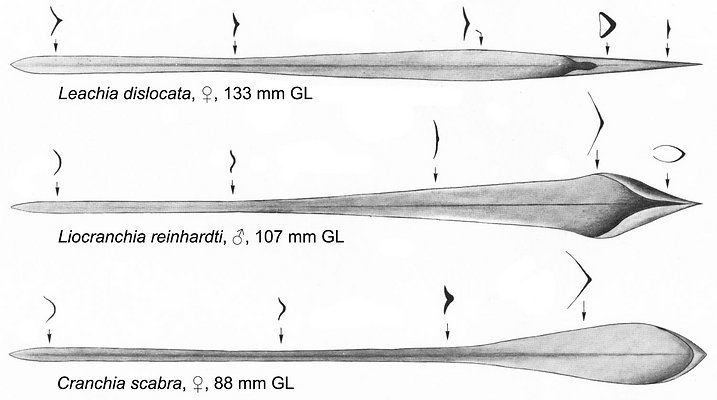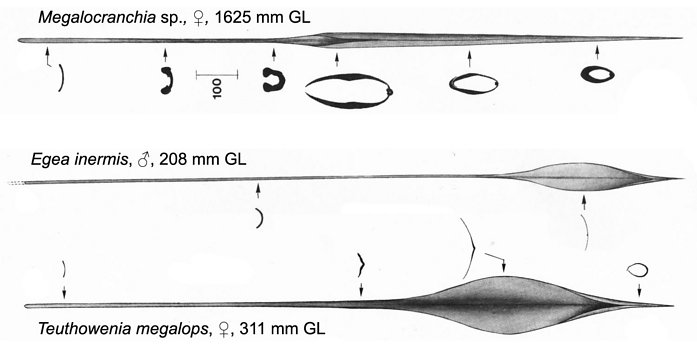The Cranchiidae contains the highest range of gladii shapes of any decapodiform family. Each genus is characterized by a distinctive shape and each clade (as defined by Voss, 1988) contain genera that show some similarities. One type of conus that is unique to the Cranchiidae (the pseudoconus: posterior edges of the vanes overlap but do not fuse) is found in six genera (Taonius, Galiteuthis, Mesonychoteuthis, Teuthowenia, Megalocranchia and Egea which form an extended clade). The very peculiar gladius of Bathothauma is unique in the decapodiformes. The gladius for one species in each genus is described below.
Representative gladii of the Cranchiinae:


Leachia dislocata - FREE RACHIS: Not clearly marked from anterior ends of vanes, but clearly less than half GL; V-shaped (cross section). Rachis keeled dorsally entire length. VANES: Spindle shaped, expand and fold inward in posterior quarter, fuse, form acutely-pointed, solid, dorsoventrally-flattened secondary conus. Liocranchia - FREE RACHIS: Moderately long, vane extensions not clearly marked; rachis keeled posteriorly. VANES: Broaden abruptly in posterior 1/5, fold inward, do not fuse or overlap (i.e., no conus present), end in acute point. Cranchia - FREE RACHIS: Longer than other genera in clade (60% of GL), slender, thickest and keeled at anterior vane insertions, keel extends to posterior end of gladius. VANES: Anterior extensions clearly marked from rhachis, fuse posteriorly, form broad, secondary conus.
Representative gladii of the Taoniinae. 1. The Bathothauma clade


Liguriella podopthalma - FREE RACHIS: Long, slender, nearly flat (in cross section), uniform in thickness. Rachis extends to posterior tip of gladius as small U-shaped channed. VANES: Short, broad, acorn-shaped, anterior extensions poorly marked from rachis; posterior borders fold ventromedially, fuse in midline, form short, broad, shallow secondary conus. Bathothauma lyromma - FREE RACHIS: Solid anteriorly, tapers posteriorly to thin, delicate filament that ends abruptly at the vanes. VANES (presumably): Very narrow, thickened, transverse bar broadens laterally as delicate, paddle-like vanes; conus absent. Sandalops melancholicus - FREE RACHIS: Long, slender, thickened, strongly tapering posteriorly, curved (in cross section). VANES: Diamond shaped with slightly concave borders; anterior extensions fairly well marked; posterior borders fold ventromedially, fuse in midline; form short, broad, pointed, dorsoventrally flattened, secondary conus. Helicocranchia pfefferi - FREE RACHIS: Relatively broader than others in clade; slightly curved (in cross section) with thickened edges. VANES: Narrow; their combined width about equals anterior rachis but with much greater thickness; anterior extensions poorly marked from rachis. Vanes fuse midventrally to form short, bullet-shaped, secondary conus. Conus with small, solid extension.
Representative gladii of the Taoniinae. 1. The Taonius clade


Taonius pavo - FREE RACHIS: Long, slender; anterior vane extensions cannot be distinguished from rachis, however, free rachis length about half of GL. VANES: Posteriorly fold ventrally, overlap, form long, hollow, filiform pseudoconus (may fuse posteriorly) about 1/3 to 1/2 of GL. Galiteuthis glacialis - Gladius overall very slender. FREE RACHIS: Long and narrow, broadest posteriorly,tapering anteriorly. VANES: Broaden abruptly in posterior half of gladius; much further posteriorly vanes fold ventrally, overlap, form short, hollow, filiform pseudoconus. Mesonychoteuthis hamiltoni - FREE RACHIS: Short and broad Rachis with rounded keel along vanes. VANES: Broadest in anterior third, fold ventrally in posterior fifth, overlap, form short pseudoconus; distally conus nearly solid with small ventral channel.
Representative gladii of the Taoniinae. 1. The Teuthowenia clade


Megalocranchia - FREE RACHIS: Relatively short, narrow, sturdy; with lunate cross-section anteriorlly becoming thickened with irregular shaped rod-like margins and U-shaped cross-section posteriorly. VANES: Abruptly broaden and fold ventrally, overlap, form long, hollow, filiform pseudoconus that may fuse posteriorly. Egea - FREE RACHIS: Very long, slender, strongly thickend. VANES: Short, spindle shaped; posteriorly fold ventrally, overlap, form short, hollow, acute pseudoconus. Teuthowenia - FREE RACHIS: Very long, slender, strongly thickend; embedded rachis with small keel extends nearly to posterior end of gladius. VANES: Short, broad, spindle-shaped (relatively larger than in Egea); posterior margins fold ventrally, overlap, form short, hollow, acute pseudoconus.
Comments
Drawings and descriptions above are taken from Toll (1982); see this source for more detailed descriptions.




 Go to quick links
Go to quick search
Go to navigation for this section of the ToL site
Go to detailed links for the ToL site
Go to quick links
Go to quick search
Go to navigation for this section of the ToL site
Go to detailed links for the ToL site